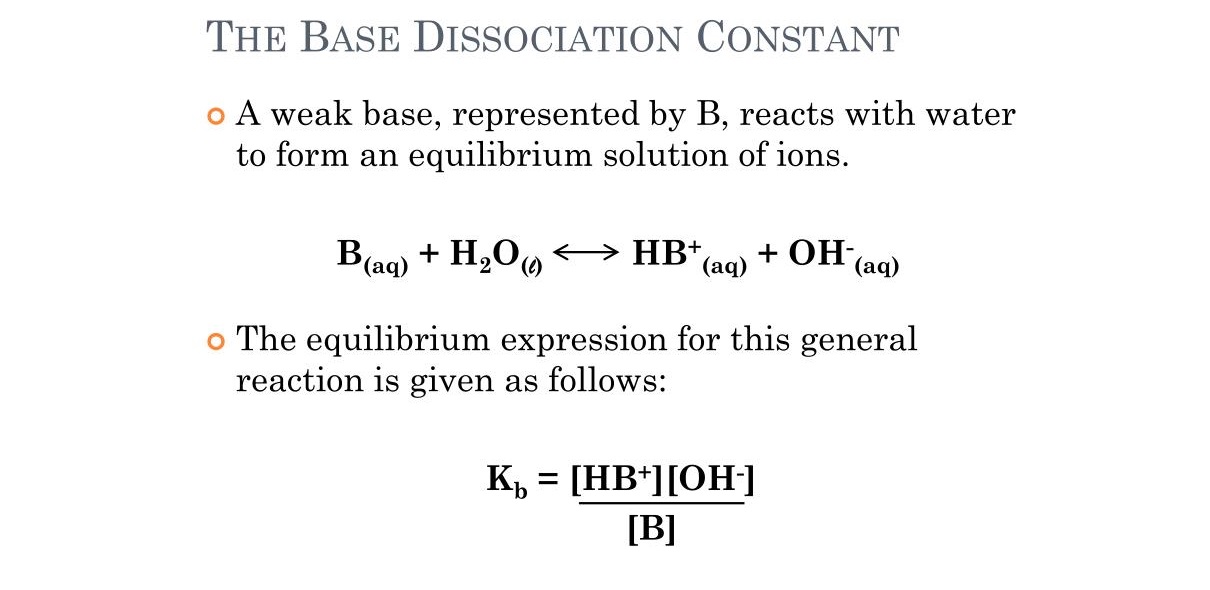
Base Dissociation Constant (Kb) is a fundamental concept in chemistry that plays a crucial role in understanding the behavior of bases in aqueous solutions. It is a measure of the strength of a base and determines the extent to which it dissociates into its respective ions in water. Kb is also closely related to pH and is used to calculate the concentration of hydroxide ions (OH-) in a solution.
In this article, we will explore 11 mind-blowing facts about the Base Dissociation Constant (Kb) that will deepen your understanding of this important concept. From the significance of Kb in acid-base reactions to its role in determining the strength of bases, these facts will shed light on the intriguing world of Kb and its practical applications.
Key Takeaways:
- Base Dissociation Constant (Kb) measures how strong a base is. Higher Kb means stronger base. It helps calculate pH, design buffer solutions, and understand biological systems.
- The pKb value is the negative logarithm of Kb. Smaller pKb means stronger base. Kb is crucial in solubility equilibrium and Lewis acid-base theory.
What is Base Dissociation Constant (Kb)?
The Base Dissociation Constant (Kb) is a measure of the extent to which a base dissociates or ionizes in an aqueous solution. It is a quantitative measure of the strength of a base.
Calculation of Kb
To calculate the Kb value for a base, you need to know the concentration of the products (the ions formed when the base dissociates) and the concentration of the undissociated base. Kb can be calculated using the equation: Kb = [B+][OH-] / [BOH], where [B+] is the concentration of the cation formed, [OH-] is the concentration of hydroxide ions, and [BOH] is the concentration of the undissociated base.
Relationship between Kb and pKb
The pKb value is the negative logarithm (base 10) of the Kb value. It is a measure of the acidity of the conjugate acid of the base. The smaller the pKb value, the stronger the base. pKb = -log(Kb)
Kb and the Strength of Bases
The value of Kb determines the strength of a base. Higher values of Kb indicate a stronger base, as it dissociates more readily in water. Strong bases have higher Kb values, while weak bases have lower Kb values.
Relationship between Kb and Ka
The Ka value (acid dissociation constant) and the Kb value are related through the equation: Kw = Ka * Kb, where Kw is the ion-product constant of water. This equation shows that the stronger the acid (higher Ka), the weaker the base (lower Kb).
Kb and Conjugate Acids
Kb values are related to the strength of the conjugate acid of a base. The stronger the conjugate acid, the weaker the base. This relationship is reflected in the Kb value, with stronger acids corresponding to lower Kb values.
Kb and pH
Kb values can be used to calculate the pH of a solution containing a base. By knowing the concentration of the base and the Kb value, the concentration of hydroxide ions and consequently the pH can be determined.
Kb and Lewis Bases
Kb values are also relevant in the Lewis acid-base theory, which considers the donation of electron pairs. In this theory, bases accept electrons, and their strength can be determined by their Kb values.
Kb and Biological Systems
Kb values are important in understanding the behavior of bases in biological systems. Many essential biological molecules, such as amino acids and enzymes, rely on specific pH levels, which are influenced by the Kb values of relevant bases.
Kb and Buffer Solutions
Kb values play a crucial role in designing buffer solutions. Buffer solutions maintain a stable pH and consist of a weak base and its conjugate acid. The Kb value of the base helps determine the concentration ratio required for an effective buffer.
Kb and Solubility Equilibrium
When considering the solubility equilibrium of a slightly soluble base, the Kb value is essential in determining the concentration of the base in a saturated solution. It allows us to understand the extent to which the base ionizes or remains undissociated in the solution.
Conclusion
In conclusion, the base dissociation constant (Kb) is a crucial concept in chemistry that quantifies the strength of a base in aqueous solution. Understanding Kb enables scientists to predict the extent of base ionization and determine the pH of a solution.Throughout this article, we have discovered 11 mind-blowing facts about Kb. We have learned that Kb values can range from extremely small to very large, with smaller values indicating weaker bases and larger values indicating stronger bases. We also uncovered the relationship between Kb and the corresponding acid dissociation constant (Ka), known as the acid-base conjugate pair.Furthermore, we explored how Kb can be calculated using experimental data or derived from Kb values of similar compounds. We delved into the importance of Kb in various applications such as designing buffer solutions, understanding solubility behavior, and evaluating the effectiveness of basic drugs.Intriguingly, we discovered that the Kb values for different bases can vary widely depending on factors such as molecular structure, charge distribution, and resonance effects. We also noted that Kb values can be influenced by temperature, with some bases exhibiting greater ionization at higher temperatures.It is essential to grasp the significance of Kb in acid-base chemistry as it helps us comprehend the behavior of bases and their impact on chemical reactions. By familiarizing ourselves with the remarkable facts about Kb, we can deepen our understanding of the fundamental principles that govern chemical processes.
FAQs
Q: What does the base dissociation constant (Kb) represent?
A: The Kb quantifies the strength of a base in aqueous solution and indicates the extent of base ionization.
Q: How are Kb and Ka related?
A: Kb and Ka are related as the Kb value of a base and the Ka value of its corresponding acid (known as the acid-base conjugate pair) are connected through the equation Ka × Kb = Kw, where Kw is the ionization constant of water.
Q: How can we calculate Kb?
A: Kb can be calculated by using experimental data or derived from the Kb values of similar compounds.
Q: What are the practical applications of Kb?
A: Kb has various applications such as designing buffer solutions, understanding solubility behavior, and evaluating the effectiveness of basic drugs.
Q: How does temperature affect Kb?
A: Temperature can influence Kb values, with some bases exhibiting greater ionization at higher temperatures.
Q: Do all bases have the same Kb values?
A: No, the Kb values for different bases can vary widely depending on factors such as molecular structure, charge distribution, and resonance effects.
Unraveling the mysteries of chemistry doesn't stop with base dissociation constants. Dive deeper into the fascinating world of dissociation constant by exploring the surprising facts about acid dissociation constant Ka. Gain a comprehensive understanding of chemical equilibrium through captivating insights. Expand your knowledge even further with mindblowing facts about basicity constants of weak bases. Continue your journey of discovery and unlock the secrets of chemistry today!
Was this page helpful?
Our commitment to delivering trustworthy and engaging content is at the heart of what we do. Each fact on our site is contributed by real users like you, bringing a wealth of diverse insights and information. To ensure the highest standards of accuracy and reliability, our dedicated editors meticulously review each submission. This process guarantees that the facts we share are not only fascinating but also credible. Trust in our commitment to quality and authenticity as you explore and learn with us.


